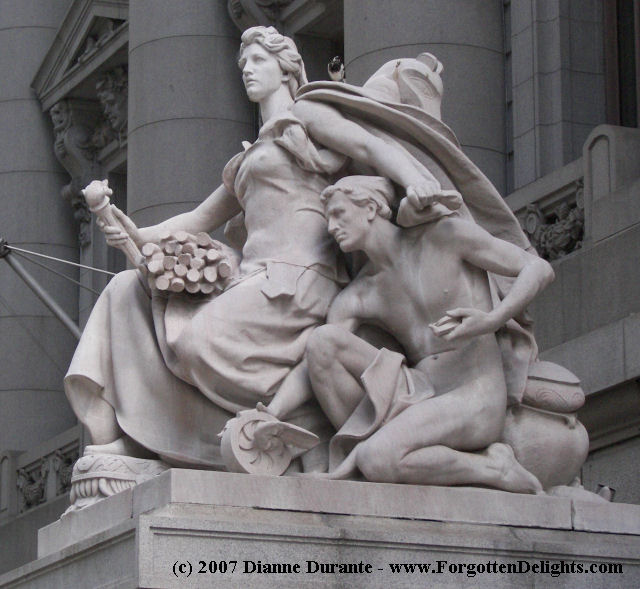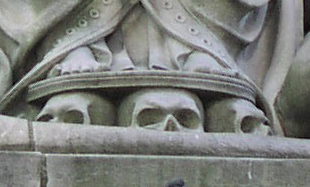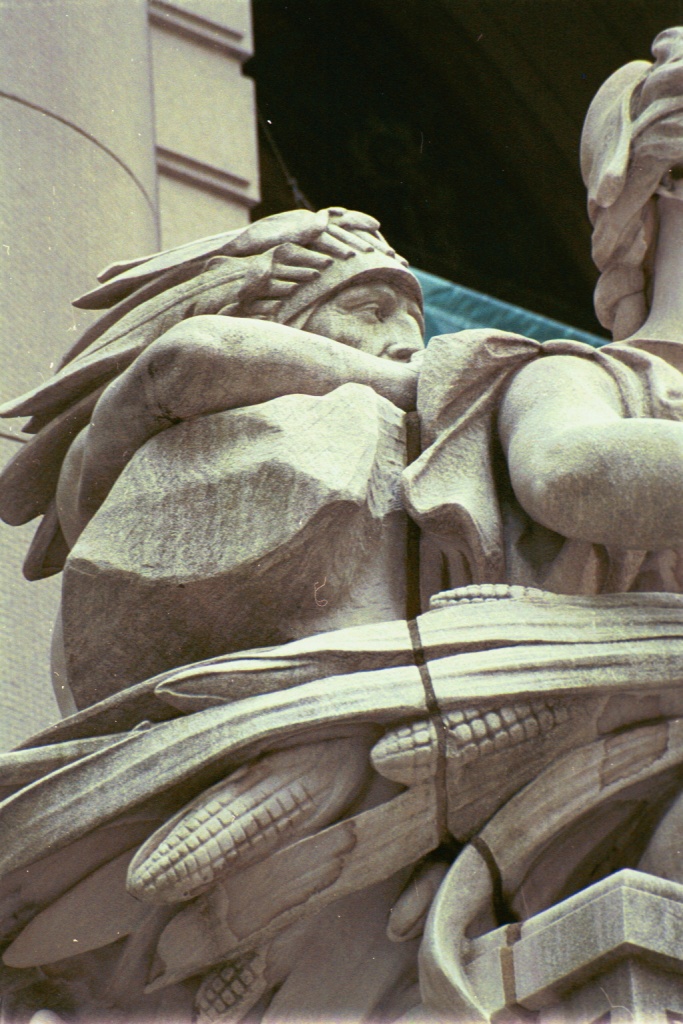- Sculptor: Daniel Chester French
- Dedicated: 1907
- Medium and size: Marble (ranging from 9.5 to 11 feet), each pedestal about 9 feet
- Location: In front of the United States Customs House, facing Bowling Green between State and Whitehall Streets
The main essay on French’s Continents is in Outdoor Monuments of Manhattan. This page has comments from the New York Times, 1905 and 1906, before the sculptures were unveiled, plus a few other comments.
Details of the Continents (1905 models)
On 4/30/1905, the New York Times ran a “For Four Marble Groups. Symbols of Continents for the Custom House by D.C. French Shown,” describing a reception at Daniel Chester French’s studio to display the finished clay models of the Continents. The descriptions are great for helping modern viewers notice and understand the sculptor’s intent, although some details of the design were subsequently changed – as is clear from the models preserved at Chesterwood and the correspondence recorded in Richman (Daniel Chester French, An American Sculptor, pp. 103-111).
America
America is described thus:
The young woman with alert face, raised eyebrows, and a flaming torch in her hand carries on her lap a sheaf of maize stalks with the ripe ears of corn. On the side and front of her throne are hieroglyphs hinting at the Mexican inscriptions. By her side kneels a partially draped man guiding a winged wheel before him on the ground.”
“At her back, with plumed head close to her ear, kneels an Indian chief. As one ascends the stair to the main entrance this group will be on the left, with the crouching figure of Invention [this is the only source to call the figure “Invention”] near at hand. Just behind the youth is a group of attributes – architecture, literature, painting, &c. – giving by their mass a pyramidal outline to the group when seen from this side.”
“For Four Marble Groups. Symbols of Continents for the Custom House by D.C. French Shown,” New York Times 4/30/1905
NOTE: The finished marbles don’t have the attributes of architecture, etc.; they have Native American pottery and a totem pole.

Daniel Chester French, America (one of four Continents), 1907. Customs House, Bowling Green, New York. Photo copyright © 2019 Dianne L. Durante 
Daniel Chester French, America (one of four Continents), 1907. Customs House, Bowling Green, New York. Photo copyright © 2019 Dianne L. Durante
Europe
Here’s Europe:
To the right hand as one mounts the stairs will sit on a Greek throne, having riders from the Parthenon in low relief on its base, the draped figure of Europe. She rests her left arm on a big, old-fashioned book, and this in turn rests on a big globe of the earth. Behind is a figure with drapery over the head, pondering upon a skull – like the grave digger in ‘Hamlet.’ On the back of the throne is an eagle with spread wings and thunderbolt. [I think it might be the top of a Roman standard (battle flag) – at least, I can’t see a thunderbolt.] On the left side rises the prow of a galley, which terminates in the snarling mask of a lion. [NOTE: The finished marble has 3 prows.]
To indicate the supremacy of Europe in civic matters, the sculptor has given her the crenellated crown of Cybele, mother of the gods of Greece.”
[NOTE: I couldn’t find a good discussion of the significance of this type of crown, so I didn’t mention it in Outdoor Monuments.]
“One clenched hand is on the big book, the other rests on the prow of the ancient galley. Europe gazes forward with uplifted chin, wearing a defiant look, as if ready to repel aggression.” [NOTE: There certainly was aggression building up: the Continents were dedicated in 1907, when European leaders were concocting the web of alliances that eventually engulfed Europe in World War I.]
“For Four Marble Groups. Symbols of Continents for the Custom House by D.C. French Shown,” New York Times 4/30/1905

Asia
Near the Whitehall corner will stand a throne bearing a woman in an Assyrian miter [a tall, pointed hat], with her eyes closed like a Buddha and a little effigy of Buddha in her lap.
The right hand holds the stalk of a lotus … [NOTE: no mention of the snake: I wonder if it was a late addition, or just difficult to see? It’s visible above at the far right of the lotus stem], … the left is laid palm downward on her knee. The footstool before the throne rests on skulls. A nude Asiatic to the right lays his forehead on the ground, and by her side marches an attenuated figure like an Indian fakir, with trembling limbs and head bowed down, followed closely by a woman with closed eyes.
The bosom of the symbolized Asia is covered with strings of jewels. To the left, with back turned and head fawning near her shoulder, sits a big tiger, while directly behind her back is a cross with rays.
“For Four Marble Groups. Symbols of Continents for the Custom House by D.C. French Shown,” New York Times 4/30/1905

Daniel Chester French, Asia (one of four Continents), 1907. Customs House, Bowling Green, New York. Photo copyright © 2019 Dianne L. Durante 
Daniel Chester French, Asia (one of four Continents), 1907. Customs House, Bowling Green, New York. Photo copyright © 2019 Dianne L. Durante
Africa
If Asia sits erect, her eyes closed in ecstatic meditation, Africa seems to slumber as she sits with left elbow on the head of her lion, right elbow on a reduction of the famous Sphinx. The features are somewhat thick, the lips and chin suggest the negro, but the nose is bent, the hair is long, and it is continued in a big plait to the waist. Behind and near the Sphinx is a figure entirely covered with drapery save for the toes of one foot and the eyes under the shadow of the cloak, representing, perhaps, the mystery of the Dark Continent. The hands of this figure [NOTE: I think he’s talking about Africa again] are loose and slightly incurved, so as to accentuate the idea of sleep, which is already marked by drooping head and closed eyes. Thus we have Europe and America with eyes open and alertness in the features; but Asia and Africa either brooding on religious themes or fast asleep.
“For Four Marble Groups. Symbols of Continents for the Custom House by D.C. French Shown,” New York Times 4/30/1905

Details of the Continents, 1906
In a New York Times article of 1/14/1906, “World’s Greatest Customs House Will Soon be Completed,” the reporter describes the Continents again.
Asia
[Asia is] the personification of a mysticism that slumbers through countless centuries, regardless of the sufferings of the ignorant multitudes crouched at her knees. … behind her appears the approaching cross and sun of a conquering religion.
“World’s Greatest Customs House Will Soon be Completed,” New York Times 1/14/1906

Africa
[Africa] is seated between the lion and the sphinx, a veiled figure of mystery at her back, an expression of hopelessness and world-weariness in her bowed head. [NOTE: I think she’s sound asleep, not depressed.]
“World’s Greatest Customs House Will Soon be Completed,” New York Times 1/14/1906
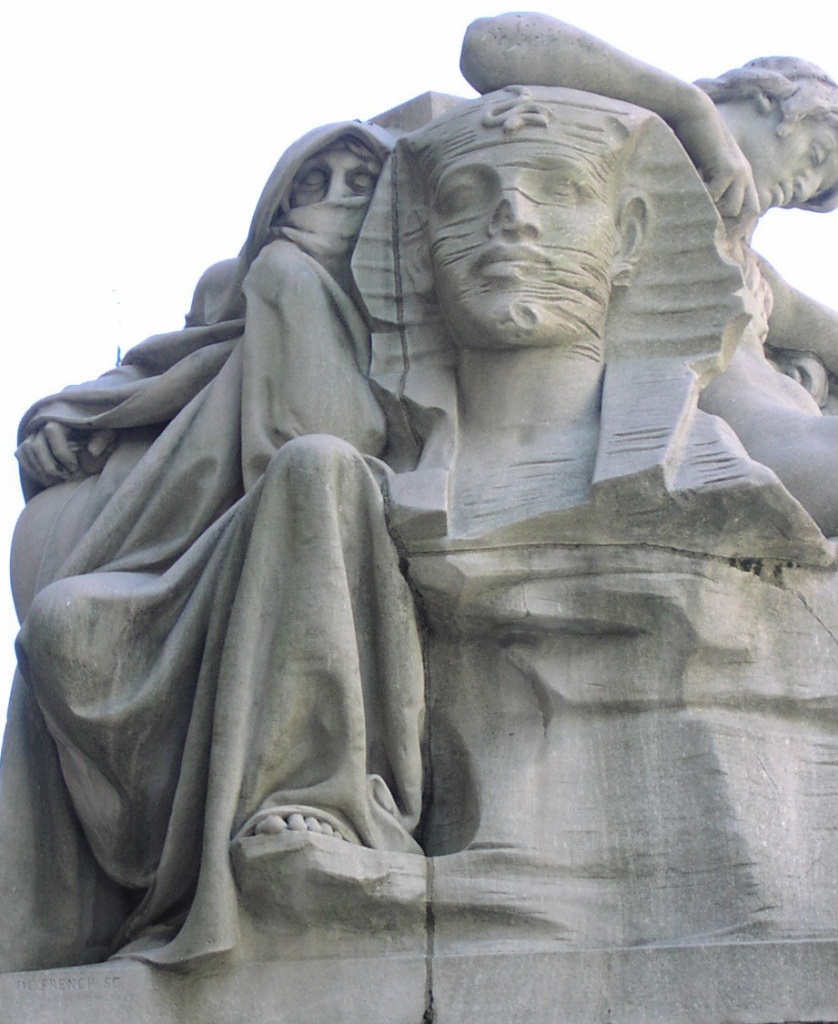
Europe
[Europe] offers a fine contrast to the two typifying the darker and older continents. Crowned and seated on a throne covered with emblems of past achievements, one hand rests on the mighty book of the past, the other is clasped above the prow of a vessel, while the eyes look calmly forward to the future.
“World’s Greatest Customs House Will Soon be Completed,” New York Times 1/14/1906
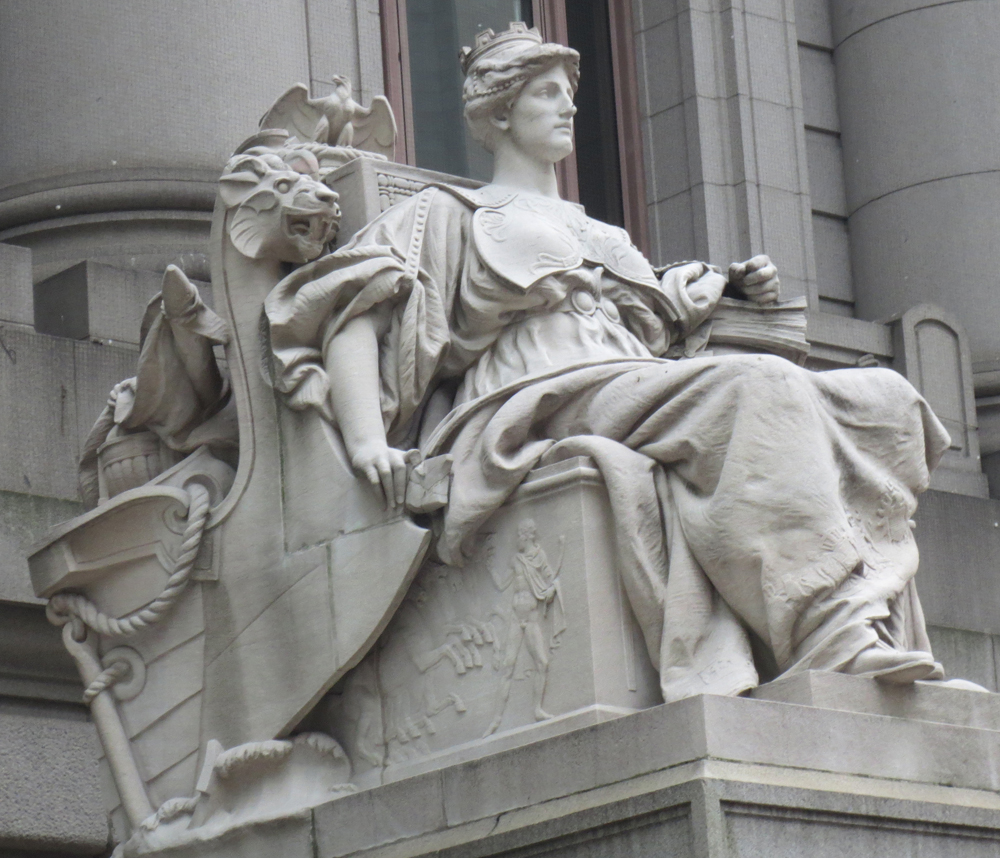
America
[America] is portrayed as a youthful woman of rare beauty seated on a stone covered with barbaric inscriptions. The pose of the head, the forward movement of the body, are full of energy and hopeful expectancy. A lighted torch is in one hand, sheaves of corn rest upon the knees. With arms folded on a rock at her back, an Indian in all the panoply of primitive splendor peers over her shoulder. At her side and under the protecting folds of her mantle kneels a half-nude masculine figure, strong and reliant, with the implements of industry in his hands, denoting labor.
“World’s Greatest Customs House Will Soon be Completed,” New York Times 1/14/1906

Daniel Chester French, America (one of four Continents), 1907. Customs House, Bowling Green, New York. Photo copyright © 2019 Dianne L. Durante 
Daniel Chester French, America (one of four Continents), 1907. Customs House, Bowling Green, New York. Photo copyright © 2019 Dianne L. Durante
Wheel of Progress
The man next to America pushes a wheel of progress. Other wheels of progress appear at Grand Central Terminal (see Glory of Commerce): look for them on the arches over the semi-circular windows of the Concourse ceiling.
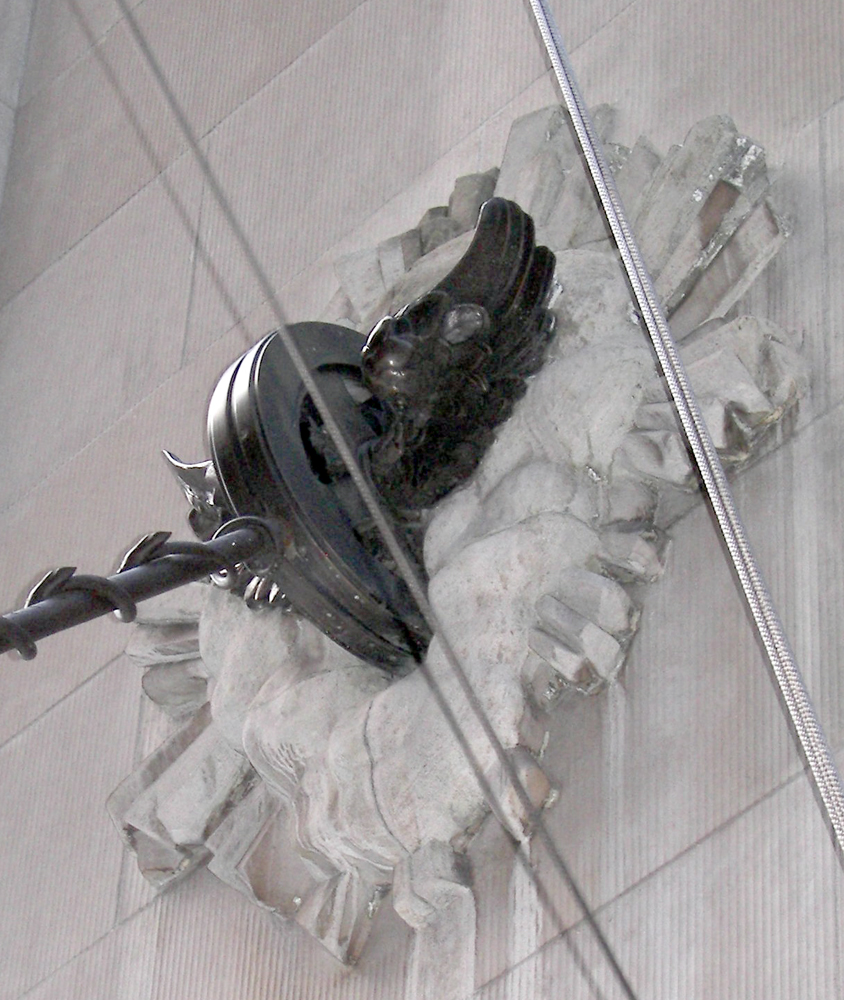
Above: The wheel of progress as a locomotive wheel, acting as a support for the porte-cochere on the south side of the former headquarters of the New York Central Railroad (48th St. between Park Avenue and Vanderbilt).
Cornice Sculptures
The sculptures on the cornice of the Customs House represent nations engaged in international trade through the ages.
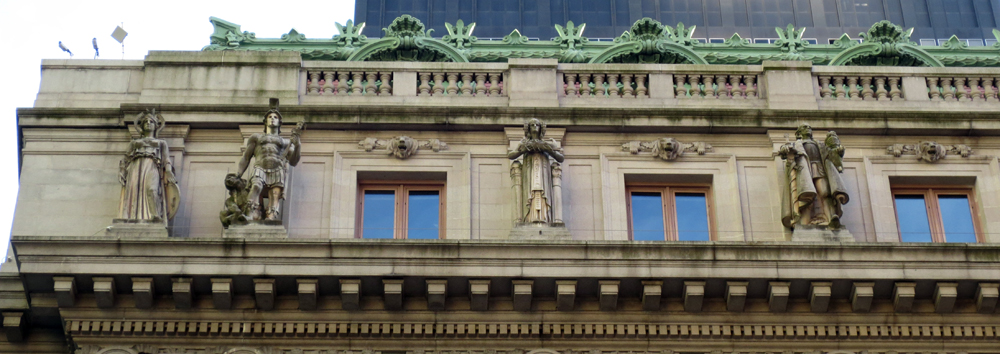
- Greece and Rome, both by Frank Edwin Elwell
- Phoenicia, by Frederick Wellington Ruckstull
- Genoa, by Augustus Lukeman, who also did the Straus Memorial

- Venice and Spain, by Mary Lawrence Tonetti
- Center: cartouche with the seal of the United States surmounted by an eagle, by Karl Bitter, who also did the Schurz Memorial. Flanking the cartouche: Peace and Strength, also by Bitter (on the fasces, see Washington at Wall St.)
- Right of the cartouche: Holland and Portugal, by Louis Saint Gaudens, younger brother of Augustus Saint Gaudens
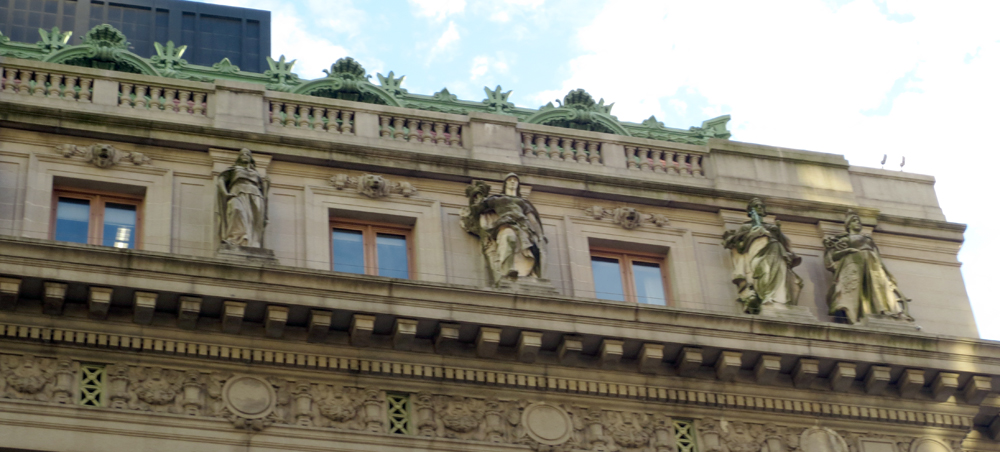
- Denmark, by Johannes Gelert
- Belgium, Albert Jaegers. The figure of Belgium was Germany until World War I, when anti-German sentiment became so intense that the statue’s nationality was changed.
- France and England, by Charles Grafly
“But playing a zombie will not give you omniscience”
The Continents show states of mind. When I look at the figure on the far right, I’m reminded of of these lines from John Galt’s speech in Atlas Shrugged.
Do not say that you’re afraid to trust your mind because you know so little. Are you safer in surrendering to mystics and discarding the little that you know? Live and act within the limit of your knowledge and keep expanding it to the limit of your life. Redeem your mind from the hockshops of authority. Accept the fact that you are not omniscient, but playing a zombie will not give you omniscience – that your mind is fallible, but becoming mindless will not make you infallible – that an error made on your own is safer than ten truths accepted on faith, because the first leaves you the means to correct it, but the second destroys your capacity to distinguish truth from error.
Ayn Rand, Atlas Shrugged
More
- Audrey Munson was probably the model for several of the Continents: see the Straus Memorial.
- In Getting More Enjoyment from Sculpture You Love, I demonstrate a method for looking at sculptures in detail, in depth, and on your own. Learn to enjoy your favorite sculptures more, and find new favorites. Available on Amazon in print and Kindle formats. More here.
- Want wonderful art delivered weekly to your inbox? Check out my free Sunday Recommendations list and rewards for recurring support: details here.
